Finding the best ETFs is an increasingly difficult task with so many to choose from. How can you choose with so many available ETF’s?

Why ETF Labels are Confusing
There are at least 44 different Financials ETFs and at least 188 ETFs across all sectors. Do you need that many choices? How different can the ETFs be?
Those 44 Financials ETFs are very different. With anywhere from 22 to 541 holdings, many of these Financials ETFs have drastically different portfolios, creating drastically different investment implications.
The same is true for the ETFs in any other sector, as each offers a very different mix of good and bad stocks. The Consumer Staples sector ranks first. Financials ranks last. Details on the Best & Worst ETFs in each sector are here.
How to Properly Assess a Sector ETF
I firmly believe ETFs for a given sector should be similar. I think the large number of Financials (or any other) sector of ETFs hurts investors more than it helps because too many options can be paralyzing. It is simply not possible for the majority of investors to properly assess the quality of so many ETFs. Analyzing ETFs, done with the proper diligence, is far more difficult than analyzing stocks because it means analyzing all the stocks within each ETF.
To be a smart investor, you understand analyzing the holdings of an ETF is critical to finding the best ETF. Figure 1 displays the best ETF in each sector.
Figure 1: The Best ETF in Each Sector

Sources: New Constructs, LLC and company filings
How to Avoid “The Danger Within”
Why do you need to know the holdings of ETFs before they buy? You need to know to be sure you do not buy a fund that might blow up. Buying a fund without analyzing its holdings is like buying a stock without analyzing its business and finances. No matter how cheap, if it holds bad stocks, the ETF’s performance will be bad.
PERFORMANCE OF FUND’S HOLDINGS = PERFORMANCE OF FUND











No Comments